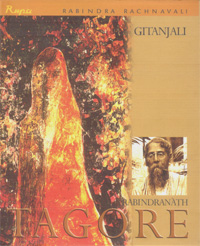Gora
Tagore’s Gora is a profoundly Indian book. It questions the identity of each of its characters as the well as the Indian nation. Caste, tradition, filial piety, patriotism and marriage are all philosophical addressed in the novel. Tagore examines the difference between religion and religious fanaticism. Tagore compares and contrasts relationship between: fathers and daughters, ruler and ruled, society and individual.
Binoy is an intelligent young man who lives in the shadow of his best friend Gora. Gora is an orphan that is raised in an orthodox Brahman family but was unaware of it. He is intensely patriotic but does heed caste rules. Around this time, a reformist movement is established “Brahmo Samaj” to counteract orthodox Hinduism as well as Christian attacks against polytheism and idol worship. Although Hindus and Brahmos lived side by side they observed different traditions. Brahmo women had more liberty than Hindu women. Binoy, being a good Samaritan, helps an injured neighbor (Poreshbabu) find a doctor. Poreshbablu is a moderate Brahmo, who philosophically advocates the middle road. Thus begins his acquaintance with a Brahmo family. He becomes a frequent visitor to their household. Their two elder daughters Lalita and Sucharita captivate his intellectual curiosity. In return they get an earful about his friend Gora. Gora become acquainted with the Brahmo household. After encountering Binoy and Gora, Sucharita rejects her predetermined suitor: Haribabu. The Brahmo family is invited to an English magistrate party. Gora visits villages outside of Kolkata and rebels against English tyranny. Lalita realizing the misdeeds of the British rebels by leaving her family and escaping the party with Binoy. Her action is scandalous by any standard. Her image and her family’s image are tarnished. Binoy protects Lalita, and eventually marries her. Both of them are abandoned by their respective communities. Gora’s mother (Anandamoyi) and Lalita father supports both the bride and groom. Gora mother considers Binoy her son. Eventually Sucharita is facing another suitor picked by her cunning aunt. Gora realizes his true identity and marries Sucharita.
If Dickens is the master of plot then Tagore is the master of character. Although Gora is slow in the beginning, plot thickens in the middle. The writing is lyrical an almost poetic in nature. Gora represents nationalism, Binoy intellectualism, Lalita feminism, Poreshbabu wisdom, Anadamoyi motherhood, and Borodasundari orthodoxy. Tagore speaks through Poreshbabu.
Binoy is an intelligent young man who lives in the shadow of his best friend Gora. Gora is an orphan that is raised in an orthodox Brahman family but was unaware of it. He is intensely patriotic but does heed caste rules. Around this time, a reformist movement is established “Brahmo Samaj” to counteract orthodox Hinduism as well as Christian attacks against polytheism and idol worship. Although Hindus and Brahmos lived side by side they observed different traditions. Brahmo women had more liberty than Hindu women. Binoy, being a good Samaritan, helps an injured neighbor (Poreshbabu) find a doctor. Poreshbablu is a moderate Brahmo, who philosophically advocates the middle road. Thus begins his acquaintance with a Brahmo family. He becomes a frequent visitor to their household. Their two elder daughters Lalita and Sucharita captivate his intellectual curiosity. In return they get an earful about his friend Gora. Gora become acquainted with the Brahmo household. After encountering Binoy and Gora, Sucharita rejects her predetermined suitor: Haribabu. The Brahmo family is invited to an English magistrate party. Gora visits villages outside of Kolkata and rebels against English tyranny. Lalita realizing the misdeeds of the British rebels by leaving her family and escaping the party with Binoy. Her action is scandalous by any standard. Her image and her family’s image are tarnished. Binoy protects Lalita, and eventually marries her. Both of them are abandoned by their respective communities. Gora’s mother (Anandamoyi) and Lalita father supports both the bride and groom. Gora mother considers Binoy her son. Eventually Sucharita is facing another suitor picked by her cunning aunt. Gora realizes his true identity and marries Sucharita.
If Dickens is the master of plot then Tagore is the master of character. Although Gora is slow in the beginning, plot thickens in the middle. The writing is lyrical an almost poetic in nature. Gora represents nationalism, Binoy intellectualism, Lalita feminism, Poreshbabu wisdom, Anadamoyi motherhood, and Borodasundari orthodoxy. Tagore speaks through Poreshbabu.
Top rated books in this category











































